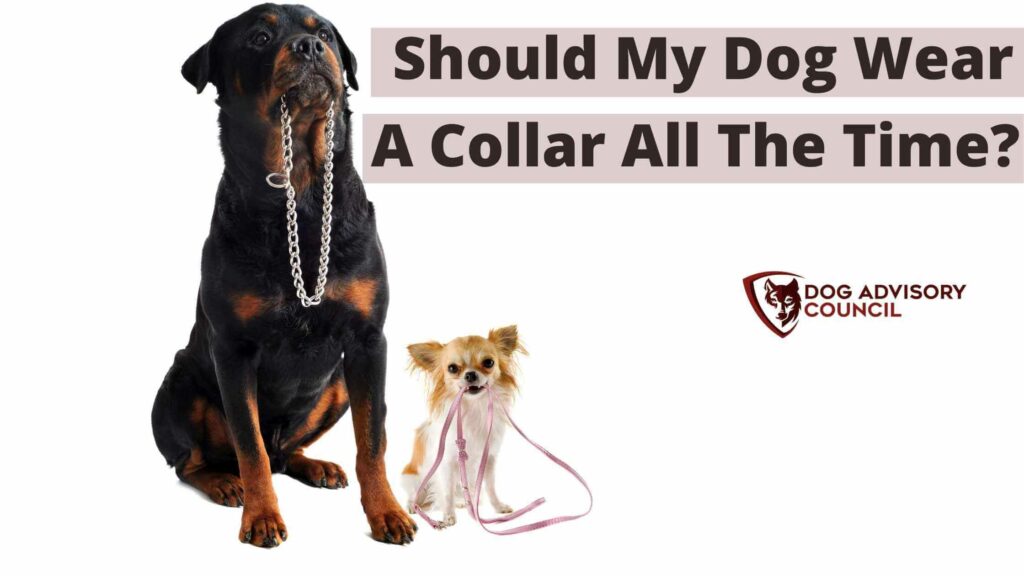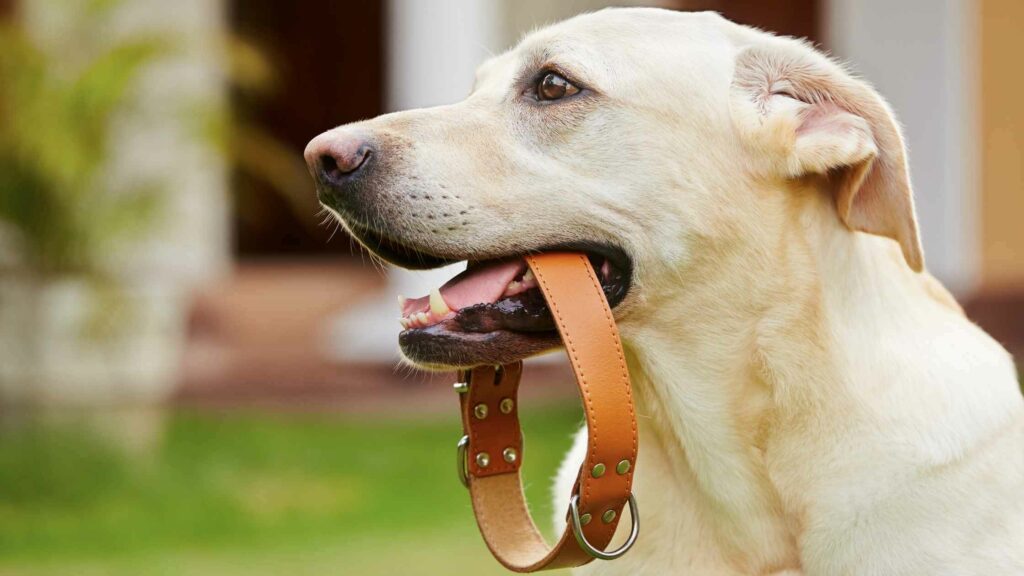
Picking out a dog collar is essential for your dog’s sense of style and safety. So, how often should your dog wear that collar? Take a look.
Dogs should always wear a collar since a collar’s main job is to hold identifying information that will help a stranger figure out where your dog is supposed to be if they were to get away from home. The right choice in a dog collar will keep your dog comfortable so that you won’t feel the need to take it off.
Should dogs sleep with their collar on?
Dogs are known for napping throughout the day, of course. You can safely allow your dog to sleep with their collar on without worry or fear. As long as your dog’s collar fits them well, there is no reason your dog can’t sleep with their collar on.
Should you take your dog’s collar off at home?
Some will take their dog’s collar off when they get home from a walk or an outing. However, this is not a great idea. Remember that your dog’s collar has the ID for who they are if they were ever to get away from you.
You should keep your dog’s collar on them even when they’re home so they will be brought back to you if they were ever to be an escape artist and get out the door or the yard without your noticing.
If your dog wears a harness, you can safely remove that when they return home. Since this is just used for dog walking, etc., you can take the harness off and only put it back on again when you head out for your next adventure with your furry friend.
How long should you leave a collar on a dog?
This really depends on the context, of course. In general, you should always have a collar on your dog, except for overnight (which we’ll get into shortly). This includes their later puppy months and all the way up until they are in their golden years.
You’ll want to change the collar every several years or more as needed. You can wash them in the washing machine or replace them with a new one when you see the collar getting dirty or smelly.
To help you get the best versatility, we recommend going for a collar with multiple size adjustments so that you can change it whenever it’s needed for your dog’s overall comfort.
This comfort and adjustment combination will be particularly important as your dog grows in their first 14 months of life. Since they grow quickly, you’ll need to adjust the collar regularly to keep them safe and comfortable.
Should I take off my dog’s collar at night?
As we hinted above, taking off your dog’s collar is safest at night. When your dogs prepare to settle in for the night at bedtime, you can take it off with relative assurance that they won’t need it.
To make it as simple as possible, make this into your dog’s routine. Associate a command with it (and a treat, of course) and get your dog used to sitting still, patiently, while you remove the collar (and then put it back on again in the morning).
This is also a good idea since your dog will be used to having you handle their neck and collar twice a day, making it familiar and routine so that it’s not a strange or panic-inducing task.
Taking their collar off at night helps them sleep much more comfortably, and it will also give their skin a break. The fur will have a chance to rise up, and your dog’s skin will get a chance to breathe and rest. It also gives your dog a chance to scratch those areas that itch under their collar!

Why do dogs freak out when you remove their collar?
If you notice that your dog tends to freak out or otherwise react when you remove their collar, it could be for several reasons. The top ones for this flurry of movement and excitement include:
- The collar is fitted too tight
- They associate the removal with something exciting or stressful
- They are itchy, or their fur is tickling them
- They forgot the collar was on
The collar is fitted too tight
If your dog’s collar is fitted too tightly, you’ll notice that removing it will really set them off. They’ll likely pant, dance around and often shake or scratch at their neck. You’ll likely notice that their fur will look pressed down to their skin, and you may even notice fur mats or red, raw skin (depending on their fur length).
You’ll want to loosen the collar and properly care for their skin and fur underneath it in the meantime. Your dog is most likely very uncomfortable, which may make them uncooperative in wearing a collar in the future!
They associate the removal with something exciting or stressful
Dogs see everything as a symptom. So they might expect something exciting or stressful after removing their collar. This emotion will make them yelp and hop around and otherwise seem like they are freaking out. It’s good to calm this behavior using your obedience training commands.
Pay attention to the reaction as much as possible. If it is stress-related, you might want to see what you can do to avoid pairing the collar removal with the stressful action so your dog won’t react as strongly. Dog stressors don’t always make sense to us, but that doesn’t mean they aren’t valid!
They are itchy, or their fur is tickling them
Sometimes the removal process will tickle them or make them itchy. The collar could fit just fine, but the movement of taking it off and playing with the buckle or the clasped hole will cause them to shake their fur out and scratch the itch. This is perfectly fine and will pass. If it happens every time, you might want to consider getting a new collar for your dog or adjusting the fit!
They forgot the collar was on
This is a funny one, but honest! Dogs often forget their collar is on since they can’t see it. So when humans remove it, they’ll basically think, “Oh, I forgot about that! Gotta shake it off.” And then vigorously shake and shimmy to get the collar’s feeling off. It’s amusing for most of us to watch since dogs always try to shrug it off as no big deal.
Why should dogs not wear collars?
While a collar is definitely a good idea for the ID tags, a collar may not always be a safe or right decision for your dog. Some of the reasons to stop putting a collar on your dog include:
- Excessive fur mats underneath
- Sensitive, raw skin that won’t clear up
- Commonly finding ticks and other pests under their collar
- Extreme stress or dislike of the collar
You can talk to your vet about the right solution in these situations. In most cases, the best replacement for any and all of these will be a harness with an ID tag on it. This is intended to be removed after a walk, so the pests won’t have anywhere to hide!
Many vets will start by recommending that your dog has more time away from the collar first, but if that doesn’t help, they’ll recommend switching your dog to a harness.
However, that leads to a pressing problem: what should your dog do for ID if they don’t wear their harness in the house? This is where you will seriously want to consider a microchip. Most pounds, charities, and even good samaritans will automatically check found dogs for a microchip if they have no collar on, so it’ll give you the same safety without the irritation of the collar!
Do you take a dog collar off in a crate?
You should consider taking your dog’s collar off when they enter their crate unless you have a breakaway collar. This kind of collar will release when there is enough pressure pulling on the collar itself.
If your dog ever gets their tags or collar stuck in the slats of the crate, it can be a choking hazard if they try to free themselves. The breakaway collar releases the collar’s security, which means they will be able to free themselves.
These are, of course, not going to be a good idea if your dog pulls on their leash while walking, though! A harness is a good idea if you decide to get a breakaway collar.
Do dogs find collars uncomfortable?
Most dogs don’t find collars uncomfortable, particularly if you get a good quality one that is fitted effectively. It’s worth getting a high-quality one that your vet can check for fit since it can make your dog’s life much more comfortable.
Why do dogs love collars?
Humans love collars on dogs, but dogs are neutral at best. They don’t particularly care if they have a collar on since they do not understand what a collar does or what it’s used for. And, of course, they often forget it’s even there until they shake their head and hear their tags rattling!
In conclusion
Dogs should wear their collars most of the time so that they always have their ID on them if they were to get away from their humans or home. You can take it off at night once your dog settles in for their nighttime snooze, but you’ll want to ensure that you put it back on in the morning for their safety.
If your dog can’t wear a collar. In that case, you can consider a microchip as an alternative and then use a harness when walking your dog since that is intended to be worn only when outside and walking on a leash.
Know someone who is wondering this question, too? Share this with them to help them be in the know!
